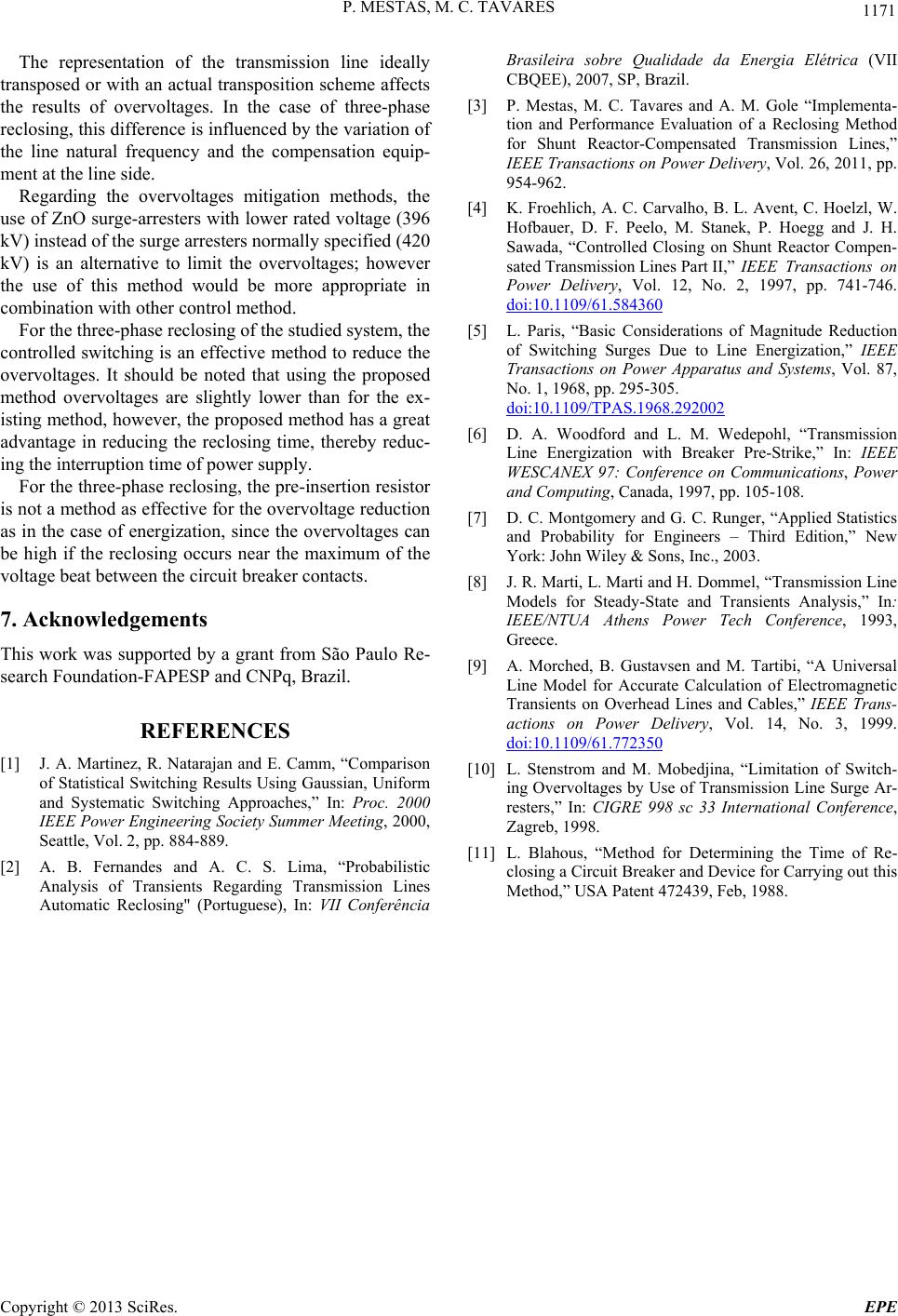
P. MESTAS, M. C. TAVARES
Copyright © 2013 SciRes. EPE
1171
The representation of the transmission line ideally
transposed or with an actual transposition scheme affects
the results of overvoltages. In the case of three-phase
reclosing, this difference is influenced by the variation of
the line natural frequency and the compensation equip-
ment at the line side.
Regarding the overvoltages mitigation methods, the
use of ZnO surge-arresters with lower rated voltage (396
kV) instead of the surge arresters normally specified (420
kV) is an alternative to limit the overvoltages; however
the use of this method would be more appropriate in
combination with other control method.
For the three-phase reclosing of the studied system, the
controlled switching is an effective method to reduce the
overvoltages. It should be noted that using the proposed
method overvoltages are slightly lower than for the ex-
isting method, however, the proposed method has a great
advantage in reducing the reclosing time, thereby reduc-
ing the interruption time of power supply.
For the three-phase reclosing, the pre-insertion resistor
is not a method as effective for the overvoltage reduction
as in the case of energization, since the overvoltages can
be high if the reclosing occurs near the maximum of the
voltage beat between the circuit breaker contacts.
7. Acknowledgements
This work was supported by a grant from São Paulo Re-
search Foundation-FAPESP and CNPq, Brazil.
REFERENCES
[1] J. A. Martinez, R. Natarajan and E. Camm, “Comparison
of Statistical Switching Results Using Gaussian, Uniform
and Systematic Switching Approaches,” In: Proc. 2000
IEEE Power Engineering Society Summer Meeting, 2000,
Seattle, Vol. 2, pp. 884-889.
[2] A. B. Fernandes and A. C. S. Lima, “Probabilistic
Analysis of Transients Regarding Transmission Lines
Automatic Reclosing" (Portuguese), In: VII Conferência
Brasileira sobre Qualidade da Energia Elétrica (VII
CBQEE), 2007, SP, Brazil.
[3] P. Mestas, M. C. Tavares and A. M. Gole “Implementa-
tion and Performance Evaluation of a Reclosing Method
for Shunt Reactor-Compensated Transmission Lines,”
IEEE Transactions on Power Delivery, Vol. 26, 2011, pp.
954-962.
[4] K. Froehlich, A. C. Carvalho, B. L. Avent, C. Hoelzl, W.
Hofbauer, D. F. Peelo, M. Stanek, P. Hoegg and J. H.
Sawada, “Controlled Closing on Shunt Reactor Compen-
sated Transmission Lines Part II,” IEEE Transactions on
Power Delivery, Vol. 12, No. 2, 1997, pp. 741-746.
doi:10.1109/61.584360
[5] L. Paris, “Basic Considerations of Magnitude Reduction
of Switching Surges Due to Line Energization,” IEEE
Transactions on Power Apparatus and Systems, Vol. 87,
No. 1, 1968, pp. 295-305.
doi:10.1109/TPAS.1968.292002
[6] D. A. Woodford and L. M. Wedepohl, “Transmission
Line Energization with Breaker Pre-Strike,” In: IEEE
WESCANEX 97: Conference on Communications, Power
and Computing, Canada, 1997, pp. 105-108.
[7] D. C. Montgomery and G. C. Runger, “Applied Statistics
and Probability for Engineers – Third Edition,” New
York: John Wiley & Sons, Inc., 2003.
[8] J. R. Marti, L. Marti and H. Dommel, “Transmission Line
Models for Steady-State and Transients Analysis,” In:
IEEE/NTUA Athens Power Tech Conference, 1993,
Greece.
[9] A. Morched, B. Gustavsen and M. Tartibi, “A Universal
Line Model for Accurate Calculation of Electromagnetic
Transients on Overhead Lines and Cables,” IEEE Trans-
actions on Power Delivery, Vol. 14, No. 3, 1999.
doi:10.1109/61.772350
[10] L. Stenstrom and M. Mobedjina, “Limitation of Switch-
ing Overvoltages by Use of Transmission Line Surge Ar-
resters,” In: CIGRE 998 sc 33 International Conference,
Zagreb, 1998.
[11] L. Blahous, “Method for Determining the Time of Re-
closing a Circuit Breaker and Device for Carrying out this
Method,” USA Patent 472439, Feb, 1988.